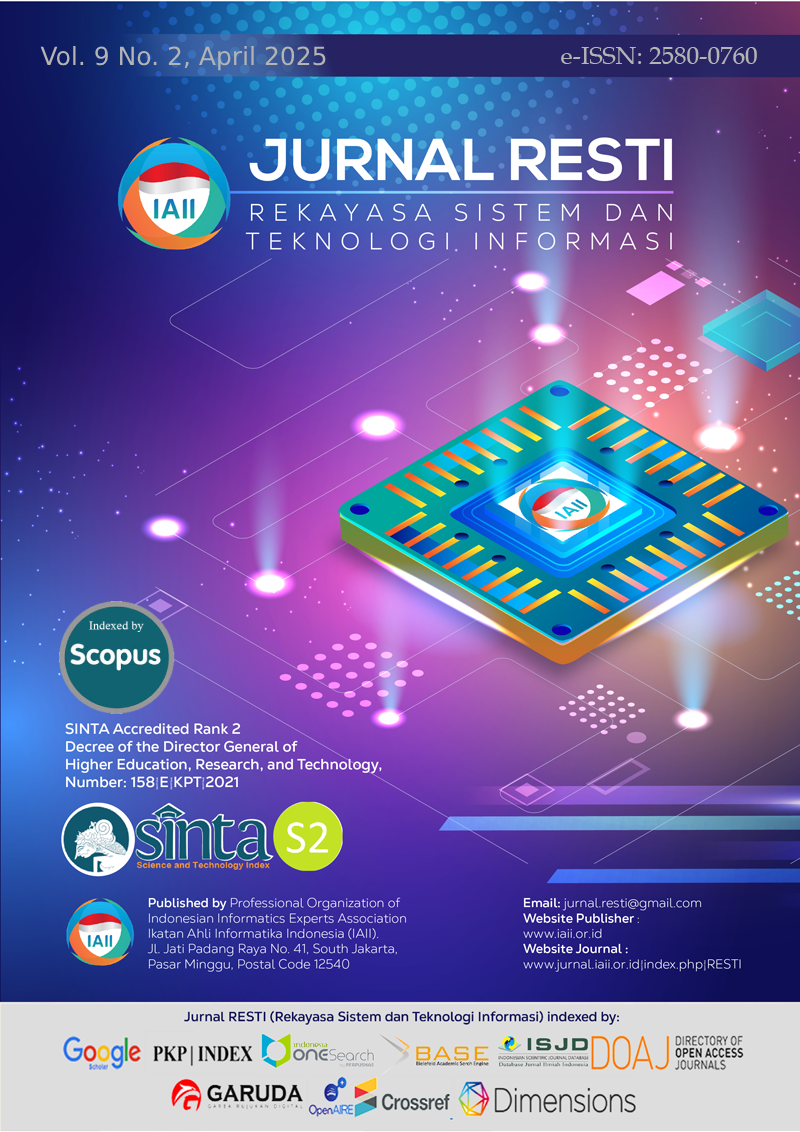Comparative Analysis of Machine Learning Algorithms for Predicting Patient Admission in Emergency Departments Using EHR Data
Abstract
Every patient who is rushed to the Emergency Department needs fast treatment to determine whether the patient should be inpatient or outpatient. However, the existing fact is that deciding whether an inpatient or outpatient must wait for the diagnosis made by the existing doctor, so if there are many patients, it generally takes quite a long time. So, to predict patient admissions to the emergency unit, a machine learning model that can be fast and accurate is needed. Therefore, this study developed a machine learning and neural network model to determine patient care in Emergency Departments. This study uses publicly available electronic health record (EHR) data, which is 3,309. The model development process uses machine learning methods (SVM, Decision Tree, KNN, AdaBoost, MLPClassifier) and neural networks. The model that has been obtained is then evaluated for its performance using a confusion matrix and several matrices such as accuracy, precision, recall, and F1-Score. The results of the model performance evaluation were compared, and the best model was obtained, namely the MLPClassifier model with an accuracy value = 0.736 and an F1-Score value = 0.635, and the Neural Network model obtained an accuracy value = 0.724 and an F1-Score value = 0.640. The best models obtained in this study, namely the MLPClassifier and Neural Network models, were proven to be able to outperform other models.
Downloads
References
D. M. King, J. P. Vakkalanka, C. Junker, K. K. Harland, and A. S. Nugent, “Emergency Department Overcrowding Lowers Patient Satisfaction Scores,” Academic Emergency Medicine, vol. 28, no. 3, pp. 363–366, Mar. 2021, doi: 10.1111/acem.14046.
P. McKenna, S. M. Heslin, P. Viccellio, W. K. Mallon, C. Hernandez, and E. J. Morley, “Emergency department and hospital crowding: Causes, consequences, and cures,” Clin Exp Emerg Med, vol. 6, no. 3, pp. 189–195, 2019, doi: 10.15441/ceem.18.022.
A. A. Chamid, Widowati, and R. Kusumaningrum, “Multi-Label Text Classification on Indonesian User Reviews Using Semi-Supervised Graph Neural Networks,” ICIC Express Letters, vol. 17, no. 10, pp. 1075–1084, 2023, doi: 10.24507/icicel.17.10.1075.
A. A. Chamid, Widowati, and R. Kusumaningrum, “Graph-Based Semi-Supervised Deep Learning for Indonesian Aspect-Based Sentiment Analysis,” Big Data and Cognitive Computing, vol. 7, no. 1, p. 5, 2023, doi: 10.3390/bdcc7010005.
N. Menteş, M. A. Çakmak, and M. E. Kurt, “Estimation of service length with the machine learning algorithms and neural networks for patients who receiving home health care,” Eval Program Plann, vol. 100, no. September 2022, pp. 0–2, 2023, doi: 10.1016/j.evalprogplan.2023.102324.
A. J. Hautala, B. Shavazipour, B. Afsar, M. P. Tulppo, and K. Miettinen, “Machine learning models in predicting health care costs in patients with a recent acute coronary syndrome: A prospective pilot study,” Cardiovasc Digit Health J, vol. 4, no. 4, pp. 137–142, 2023, doi: 10.1016/j.cvdhj.2023.05.001.
M. G. Siegel, M. J. Rossi, and J. H. Lubowitz, “Artificial Intelligence and Machine Learning May Resolve Health Care Information Overload,” Arthroscopy - Journal of Arthroscopic and Related Surgery, vol. 40, no. 6, pp. 1721–1723, 2024, doi: 10.1016/j.arthro.2024.01.007.
The Lancet Digital Health, “Machine learning to predict type 1 diabetes in children,” Lancet Digit Health, vol. 6, no. 6, p. e374, 2024, doi: 10.1016/S2589-7500(24)00098-0.
R. Daniel et al., “Predicting type 1 diabetes in children using electronic health records in primary care in the UK: development and validation of a machine-learning algorithm,” Lancet Digit Health, vol. 6, no. 6, pp. e386–e395, 2024, doi: 10.1016/S2589-7500(24)00050-5.
R. Giddings et al., “Factors influencing clinician and patient interaction with machine learning-based risk prediction models: a systematic review,” Lancet Digit Health, vol. 6, no. 2, pp. e131–e144, 2024, doi: 10.1016/S2589-7500(23)00241-8.
M. J. Rho et al., “Dr. Answer AI for prostate cancer: Intention to use, expected effects, performance, and concerns of urologists,” Prostate Int, vol. 10, no. 1, pp. 38–44, 2022, doi: 10.1016/j.prnil.2021.09.001.
R. O. Alabi, A. Almangush, M. Elmusrati, I. Leivo, and A. Mäkitie, “Measuring the Usability and Quality of Explanations of a Machine Learning Web-Based Tool for Oral Tongue Cancer Prognostication,” Int J Environ Res Public Health, vol. 19, no. 14, 2022, doi: 10.3390/ijerph19148366.
D. Benrimoh, M. Tanguay-Sela, K. Perlman, S. Israel, and J. Mehltretter, “Using a simulation centre to evaluate preliminary acceptability and impact of an artificial intelligence-powered clinical decision support system for depression treatment on the physician–patient interaction,” BJPsych Open, vol. 7, no. 1, 2021.
I. Ghanzouri et al., “Performance and usability testing of an automated tool for detection of peripheral artery disease using electronic health records,” Sci Rep, vol. 12, no. 1, pp. 1–11, 2022, doi: 10.1038/s41598-022-17180-5.
A. J. Barda, C. M. Horvat, and H. Hochheiser, “A qualitative research framework for the design of user-centered displays of explanations for machine learning model predictions in healthcare,” BMC Med Inform Decis Mak, vol. 20, no. 1, pp. 1–16, 2020, doi: 10.1186/s12911-020-01276-x.
J. C. Ginestra et al., “Clinician Perception of a Machine Learning–Based Early Warning System Designed to Predict Severe Sepsis and Septic Shock,” Crit Care Med, vol. 47, no. 11, pp. 1477–1484, 2019, doi: 10.1097/CCM.0000000000003803.
S. Jauk, D. Kramer, A. Avian, A. Berghold, W. Leodolter, and S. Schulz, “Technology Acceptance of a Machine Learning Algorithm Predicting Delirium in a Clinical Setting: a Mixed-Methods Study,” J Med Syst, vol. 45, no. 4, 2021, doi: 10.1007/s10916-021-01727-6.
K. H. Bentley et al., “Implementing Machine Learning Models for Suicide Risk Prediction in Clinical Practice: Focus Group Study With Hospital Providers,” JMIR Form Res, vol. 6, no. 3, 2022, doi: 10.2196/30946.
D. Gu, K. Su, and H. Zhao, “A case-based ensemble learning system for explainable breast cancer recurrence prediction,” Artif Intell Med, vol. 107, no. August 2019, p. 101858, 2020, doi: 10.1016/j.artmed.2020.101858.
N. Rahmayanti, H. Pradani, M. Pahlawan, and R. Vinarti, “Comparison of machine learning algorithms to classify fetal health using cardiotocogram data,” in Procedia Computer Science, Elsevier B.V., 2022, pp. 162–171. doi: 10.1016/j.procs.2021.12.130.
A. S. Zamani, A. H. A. Hashim, A. S. A. Shatat, M. M. Akhtar, M. Rizwanullah, and S. S. I. Mohamed, “Implementation of machine learning techniques with big data and IoT to create effective prediction models for health informatics,” Biomed Signal Process Control, vol. 94, no. October 2023, p. 106247, 2024, doi: 10.1016/j.bspc.2024.106247.
T. Halomoan Harahap et al., “An artificial intelligence approach to predict infants’ health status at birth,” Int J Med Inform, vol. 183, no. January, p. 105338, 2024, doi: 10.1016/j.ijmedinf.2024.105338.
A. Rahman, Z. Hossain, E. Kabir, and R. Rois, “Machine Learning Algorithm for Analysing Infant Mortality in Bangladesh,” in Lecture Notes in Computer Science (including subseries Lecture Notes in Artificial Intelligence and Lecture Notes in Bioinformatics), 2021, pp. 205–219. doi: 10.1007/978-3-030-90885-0_19.
J. C. Ho, M. Sotoodeh, W. Zhang, R. L. Simpson, and V. S. Hertzberg, “An AdaBoost-based algorithm to detect hospital-acquired pressure injury in the presence of conflicting annotations,” Comput Biol Med, vol. 168, no. June 2023, p. 107754, 2024, doi: 10.1016/j.compbiomed.2023.107754.
A. A. Chamid, W. Widowati, and R. Kusumaningrum, “Text data labeling process for semi-supervised learning modeling,” 12TH INTERNATIONAL SEMINAR ON NEW PARADIGM AND INNOVATION ON NATURAL SCIENCES AND ITS APPLICATIONS (12TH ISNPINSA): Contribution of Science and Technology in the Changing World, vol. 3165, p. 030011, 2024, doi: 10.1063/5.0216320.
A. A. Chamid, Widowati, and R. Kusumaningrum, “Labeling Consistency Test of Multi-Label Data for Aspect and Sentiment Classification Using the Cohen Kappa Method,” Ingénierie des Systèmes d’Information, vol. 29, no. 1, pp. 161–167, 2024.
Z. Cömert and A. F. Kocamaz, “Comparison of machine learning techniques for fetal heart rate classification,” Acta Phys Pol A, vol. 132, no. 3, pp. 451–454, 2017, doi: 10.12693/APhysPolA.132.451.
Mujiono Sadikin, “EHR Dataset for Patient Treatment Classification,” 2020.
Y. H. Shao, X. J. Lv, L. W. Huang, and L. Bai, “Twin SVM for conditional probability estimation in binary and multiclass classification,” Pattern Recognit, vol. 136, Apr. 2023, doi: 10.1016/j.patcog.2022.109253.
S. Kiran, G. R. Reddy, S. P. Girija, S. Venkatramulu, K. Dorthi, and V. Chandra Shekhar Rao, “A Gradient Boosted Decision Tree with Binary Spotted Hyena Optimizer for cardiovascular disease detection and classification,” Healthcare Analytics, vol. 3, Nov. 2023, doi: 10.1016/j.health.2023.100173.
M. Chabbouh, S. Bechikh, C. C. Hung, and L. Ben Said, “Multi-objective evolution of oblique decision trees for imbalanced data binary classification,” Swarm Evol Comput, vol. 49, pp. 1–22, Sep. 2019, doi: 10.1016/j.swevo.2019.05.005.
D. Wang et al., “Validation of a deep learning model for classification of pediatric pneumonia in Hong Kong,” Vaccine, vol. 42, no. 26, Dec. 2024, doi: 10.1016/j.vaccine.2024.126370.
M. Shirdel, M. Di Mauro, and A. Liotta, “Worthiness Benchmark: A novel concept for analyzing binary classification evaluation metrics,” Inf Sci (N Y), vol. 678, Sep. 2024, doi: 10.1016/j.ins.2024.120882.
P. Naga Srinivasu, G. Jaya Lakshmi, S. Canavoy Narahari, J. Shafi, J. Choi, and M. Fazal Ijaz, “Enhancing medical image classification via federated learning and pre-trained model,” Egyptian Informatics Journal, vol. 27, Sep. 2024, doi: 10.1016/j.eij.2024.100530.
J. Mushava and M. Murray, “Flexible loss functions for binary classification in gradient-boosted decision trees: An application to credit scoring,” Expert Syst Appl, vol. 238, Mar. 2024, doi: 10.1016/j.eswa.2023.121876.
T. Baidawi and Solikhun, “A Comparison of Madaline and Perceptron Algorithms on Classification with Quantum Computing Approach,” Jurnal RESTI (Rekayasa Sistem dan Teknologi Informasi), vol. 8, no. 2, pp. 280–287, Apr. 2024, doi: 10.29207/resti.v8i2.5502.
M. Pal et al., “Ensemble approach of deep learning models for binary and multiclass classification of histopathological images for breast cancer,” Pathol Res Pract, vol. 263, p. 155644, Nov. 2024, doi: 10.1016/j.prp.2024.155644.
G. S. Folli, M. H. C. Nascimento, B. P. O. Lovatti, W. Romão, and P. R. Filgueiras, “A generation of synthetic samples and artificial outliers via principal component analysis and evaluation of predictive capability in binary classification models,” Chemometrics and Intelligent Laboratory Systems, vol. 251, Aug. 2024, doi: 10.1016/j.chemolab.2024.105154.
N. D. A. Rahmah, B. Handoko, and A. A. Pravitasari, “Machine Learning Methods for Forecasting Intermittent Tin Ore Production,” J. RESTI (Rekayasa Sist. Teknol. Inf.), vol. 10, no. 5, pp. 644–650, Oct. 2024, doi: 10.29207/resti.v8i5.5990.
R. Qasrawi et al., “Hybrid ensemble deep learning model for advancing breast cancer detection and classification in clinical applications,” Heliyon, vol. 10, no. 19, Oct. 2024, doi: 10.1016/j.heliyon.2024.e38374.
A. El Kaffas et al., “Development of a Deep Learning Model for Classification of Hepatic Steatosis from Clinical Standard Ultrasound,” Ultrasound Med Biol, Nov. 2024, doi: 10.1016/j.ultrasmedbio.2024.09.020.
Risfendra, G. Febri Ananda, and H. Setyawan, “Deep Learning-Based Waste Classification with Transfer Learning Using EfficientNet-B0 Model,” J. RESTI (Rekayasa Sist. Teknol. Inf.), vol. 8, no. 4, pp. 535–541, Aug. 2024, doi: 10.29207/resti.v8i4.5875.
S. Yang, P. Varghese, E. Stephenson, K. Tu, and J. Gronsbell, “Machine learning approaches for electronic health records phenotyping: a methodical review,” J Am Med Inform Assoc, vol. 30, no. 2, pp. 367–381, Jan. 2023, doi: 10.1093/jamia/ocac216.
Copyright (c) 2025 Jurnal RESTI (Rekayasa Sistem dan Teknologi Informasi)

This work is licensed under a Creative Commons Attribution 4.0 International License.
Copyright in each article belongs to the author
- The author acknowledges that the RESTI Journal (System Engineering and Information Technology) is the first publisher to publish with a license Creative Commons Attribution 4.0 International License.
- Authors can enter writing separately, arrange the non-exclusive distribution of manuscripts that have been published in this journal into other versions (eg sent to the author's institutional repository, publication in a book, etc.), by acknowledging that the manuscript has been published for the first time in the RESTI (Rekayasa Sistem dan Teknologi Informasi) journal ;







